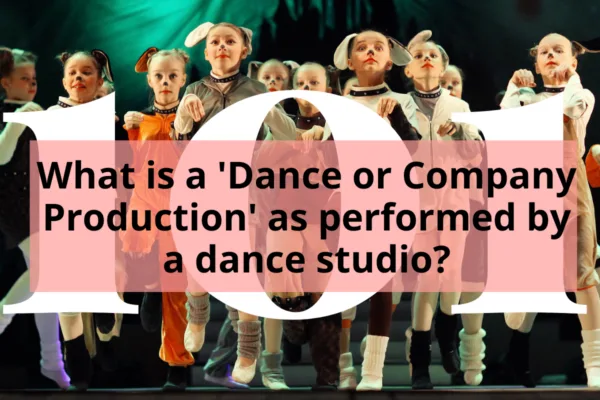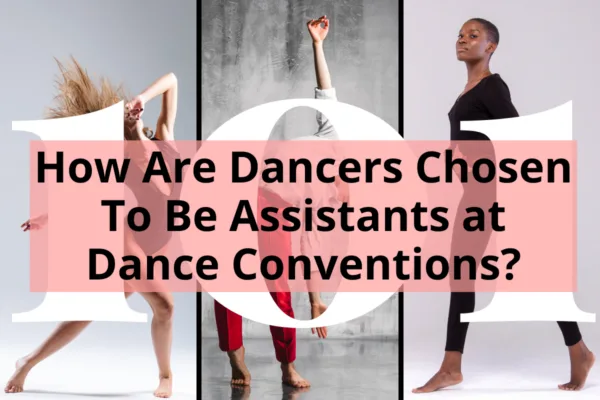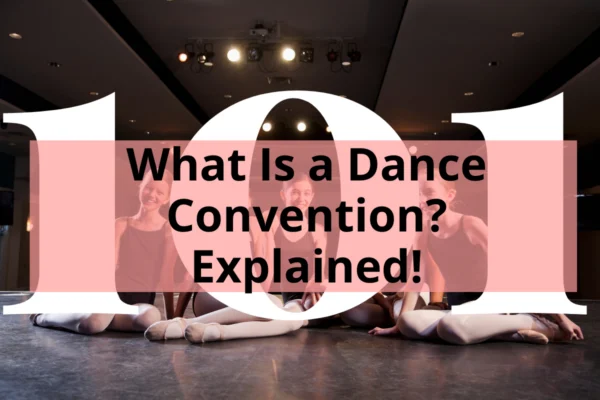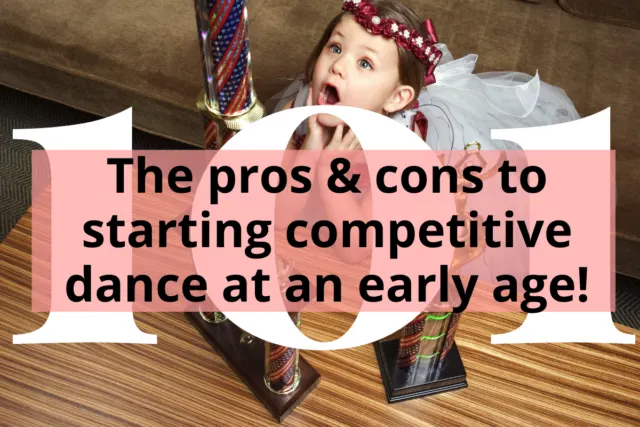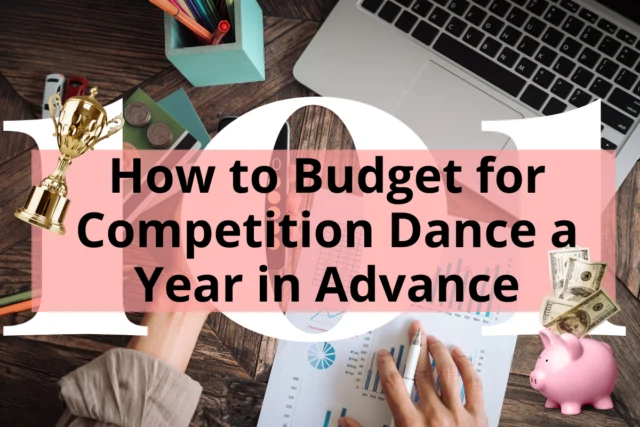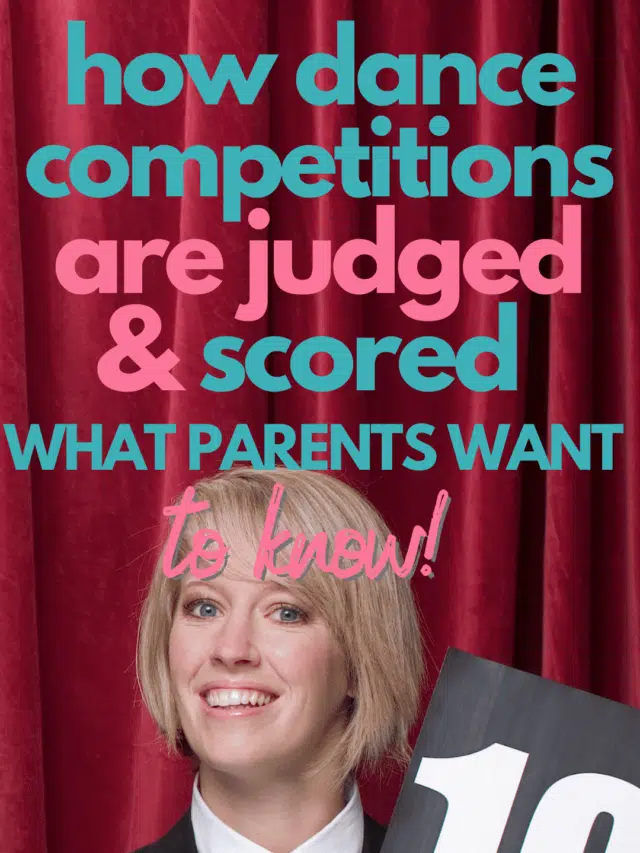If you’ve ever wondered about how dance competitions are judged, look no further!
As a veteran judge of ten years for competitions all over the United States and Canada, I’m Lesley Mealor and I am here to answer all of your burning questions about how dancers are adjudicated and scored at dance competitions.
Dance competitions are judged based on a variety of criteria, including a dancer’s age, level, technique, performance quality, choreography, and presentation. All dance competitions have a different rubric for scoring, but a judge will always take these things into consideration when adjudicating.

Because of the variety of competitions in the dance world, and the fact that there is no governing body of dance competitions, differences between events are to be expected. For a list of competitions just in the US check out our article 2022 Ultimate USA Dance Competition List by State with Links
But if you’re a new dance parent and have never been to an event, it can be confusing to watch the awards ceremony – what is a platinum? Who are the juniors?
Why didn’t Sally make it into the top 10 at this event but she was 3rd place at the last one?
Never fear – you will be ready to sit through an awards ceremony armed with this new knowledge, and you might even be able to help out a new dance parent next year!
- The 7 Criteria Dance Competition Judges Use To Score Competitors
- The Dance Competition Scoring Sheet
- How Do Judges give Dancers their Score and Critique?
- The Adjudication Scales & Award Levels at Dance Competition
- What Are The Overalls, and How Are They Different From Adjudication?
- What Is The Title Category At a Dance Competition?
- How To Score High At a Dance Competition
- How Are Dance Competition Judges Qualified to Judge a Dance Competition?
- How Are Dance Competition Judges Employed?
- You are now armed and ready!
- Looking for more information about Dance Competitions?
The 7 Criteria Dance Competition Judges Use To Score Competitors
When judging a dance competition, many considerations come into play.
Almost all dance competitions include the following 7 categories on the scoring rubric:
- Age
- Level
- Technique
- Performance Quality
- Choreography
- Presentation
- Overall Impression
1. Age of the Dancers
A dancer’s age (or the average age of the group) will always be considered – for example, all 8-year-old solos will be judged against each other, not compared to the 15-year-old solos.
Most competitions group several ages together into age divisions, with different names for those divisions.
The 6 and under division is often called the Mini or Petite Division, while the Senior Division includes dancers ages 16 to 18.
In between, you have the Juniors ranging in age from 8 to 11, and the Teens ranging from 12 to 14 or 15.
Depending on the competition, the ages might go up or down by a year – some Senior Divisions include 15 year olds.
3. Level of the Dancers
Levels are a hotly contested debate in the dance competition world.
In the early days of dance competitions (the late 1970s through the mid-90s), all dancers competed against each other, without regard to their level.
That usually meant that there were only three awards given out in each age division and style – first, second, and third place in Junior Jazz Solo, for example.
Even if there were 100 participants in the Junior Jazz Solo category, only three awards were given and maybe an honorable mention or two.
Everyone else went home with a critique tape (or simply a written critique) and the drive to work harder next time.
Fast forward to the late 90s, dance competitions in the United States began to add levels to their events.
This meant that dance studios could place their more novice or beginner-level dancers in a lower tier to compete against other dancers who trained similarly.
Dancers who trained extensively could stay at the top level of competition and compete against other dancers, so more people had a chance to place.
These days, most dance competitions have between two and five levels.
It is up to the dance teacher or studio owner to place their dancers at the correct level at each event.
The criteria for levels range from how many hours a dancer trains, to how many years they’ve been dancing, to what skills are in the routine.
3. Technique
A dancer’s technique is always given a majority of the score at a competition.
Technique refers to the skillful and efficient way of carrying out a task, and in this case, the task is the dance steps for each style.
Just like in any context, there is a proper way to execute a skill, and when presenting a routine to be judged at a dance competition, the most important piece of a routine is often its technique.
4. Performance Quality

Nearly equal in importance as technique, a dancer’s performance quality is given a majority of the score as well. Performance quality refers to the execution of the choreography – is it entertaining? Does the dancer have the right energy for the piece? Are they engaging to watch? An audience should be captivated by a dancer’s performance.
5. Choreography
Choreography also plays into the score at a dance competition, although this is also contested in the dance world.
Good choreography includes a clear story or idea, interesting physical levels, transitions, age-appropriate movement and content, and an unique point of view.
Some will say it’s unfair to judge a dancer on choreography, because most of the time at a dance competition, the choreography is out of the dancer’s control.
But, poor choreography can often trump the very best technique, so many competitions will include it on the scoring rubric so that dancers and teachers can understand exactly why a dance scored a certain way.
6. Presentation
Presentation is often given a smaller percentage of the score but is always included in some form on a scoring rubric.
As a judge and an educator, one of my favorite things to say is, “You can’t control so many things about a dance competition, but you can always control how you present yourself.”
Presentation includes costuming, hair and makeup, and how you walk on and off stage, among other things.
You may fall out of your triple pirouette, but a judge will always appreciate tights with no holes, shoes that match, a confident entrance, and neat and tidy hair.
7. Overall Impression
The overall impression is typically given the lowest point value, and is a place where a judge can deduct for something like inappropriate music selection, lack of difficulty in the routine, or simply give the full point value if everything about the routine checks out.
The Dance Competition Scoring Sheet
Most dance competitions use a point system to score dancers.
Three judges use 100 points each to score routines, and those 100 points are divided up among the different categories in the rubric.
A sample scoring rubric might look like this:
| Technique | 40 |
| Performance | 30 |
| Choreography | 15 |
| Presentation | 10 |
| Overall Impression | 5 |
| Total | 100 |
How Do Judges give Dancers their Score and Critique?
As the dancers perform their routine, judges speak into a microphone that records their commentary and critiques over the video of the routine.
Usually recorded on a zip drive, the critiques are given to the studio owner at the end of the event.
Audio critiques can be compared to a sportscaster speaking during a game, but instead of only giving a play-by-play description of what’s going on, the adjudicator is giving feedback in real-time about each step, phrase of movement, or concept that is being performed.
While they are speaking and watching, the judge is also doing math in their head to determine what points to give the dancer.
The dancer may be an excellent technician, but a poor performer, so their technique score will be higher than their performance score.
In some competitions, judges are asked to use decimals to avoid ties.
Luckily for the judges, competitions rarely make us do that math in our heads like in the early days of these events.
Now, software created specifically for dance competitions exists to tally up the scores as they’re entered, so judges can concentrate more on the valuable critiques and advice they’re giving the dancers.
After all, the experience of a competition is so much more than just a score!
The Adjudication Scales & Award Levels at Dance Competition
The scale for adjudication at a competition can sometimes vary depending on the levels, which were mentioned previously.
This is one of the most confusing parts of dance competitions for the uninitiated.
For example, Celebration Talent Competition has three levels of competition – Protostar (the beginner level), Rising Star (the intermediate level), and Shining Star (the advanced level. Their adjudication scales look like this:
| Protostar | |
|---|---|
| Platinum | 280-300 |
| High Gold | 264-279.9 |
| Gold | 247-263.9 |
| High Silver | 264.9 & Under |
| RISING STAR | |
|---|---|
| Ruby | 290-300 |
| Platinum | 285-289.9 |
| High Gold | 269-284.9 |
| Gold | 253-268.9 |
| High Silver | 252.9 & Under |
| Shining Star | |
|---|---|
| Diamond | 294-300 |
| Platinum | 288-293.9 |
| High Gold | 273-287.9 |
| Gold | 258-272.9 |
| High Silver | 257.9 & Under |
As you can see, there is a 20 point spread for the highest award in the Protostar category, the Platinum, and only a 6 point spread for the highest award in the Shining Star category, the Diamond.
When your dancer is at an awards ceremony, be sure to study your program which may indicate which routines are in what levels, so it makes a little more sense when you listen to the awards.
As you can see, gone are the days of Olympic-style medal names.
No longer just Gold, Silver, and Bronze, now the lowest most competitions will award is a High Silver, and the highest award can range from Platinum, to Diamond, to Titanium as competitions event organizers strive for uniqueness in the industry.
What Are The Overalls, and How Are They Different From Adjudication?
In addition to a dancer’s adjudication score, most competitions also award overall awards, which get more specific in terms of where a dancer places within their age category and style of dance.
Typically, a dance competition will announce the top 5 or 10 dances in an overall category in this fashion – “First Place in the Shining Star Division, 8-10 Year Old Solo in the Jazz Category with a score of 296.5 goes to ‘We’ve Got the Beat’!”
Some competitions only award overalls based on age and level, and eliminate the style altogether, grouping all the Shining Star Division 8-10 year old solos together for overalls.
When a dancer wins an overall award, they receive an additional trophy, pin, or plaque depending on the competition.
What Is The Title Category At a Dance Competition?
The title category is an additional competition within the competition, that usually incurs an additional fee as well.
A soloist can enter into the title category to compete for a competition’s “Miss” or “Mr.” title, or something like “Dancer of the Year”.
Normally, the solo a dancer enters for a title is not eligible for overalls.
Some competitions include an interview or audition class as a part of the title competition, in addition to the solo a dancer competes.
Title winners gain prizes like personalized jackets, trophies, and sometimes cash!
When selecting a routine for a title, it’s important to lead with your best style, as the title category is usually fierce!
How To Score High At a Dance Competition

After looking at the adjudication scales, which I showed you early in a table, you can see that the area with the most points available is the technique score.
It is very hard to score well at a dance competition without having a high technique score.
A dancer can be the very best performer out there, with personality, great eye contact, and a winning smile, but if their feet aren’t pointed in leaps or they fall out of turns, that low technique score will tank an otherwise a great dance.
Similarly, if a technician is completely solid in a multiple turn sequence, soars above the clouds in a grand jeté with a soft landing like a cat, or nails an intricate rhythm pattern, but looks miserable while doing so, that performance score might be low enough to bring down the overall score even with a high technique score.
It’s important to remember at a dance competition that your score isn’t the end-all, be-all of that day, or of anyone’s dance career.
Dance competition judging is subjective, and includes opinions about the art as well as hard and fast facts about technique.
Your dancer shouldn’t be discouraged if their score fluctuates between events.
A dance competition is one day, with three people giving their educated opinion on the piece being presented before them. If you change one thing about that scenario, the score could change.
If you are wanting some information on how to help you dancer improve check out some of the articles I have written below:
How To Help Your Child Improve in Jazz Dance at Home!
How To Help Your Child Improve in Lyrical Dance
How To Help Your Child Improve in Tap Dance at Home
How Are Dance Competition Judges Qualified to Judge a Dance Competition?
A good dance competition judge has experience both in the studio and on the professional stage.
They understand how to give helpful critiques with actionable advice on how to execute a step.
They also understand how to score fairly with critiques that back up that score.
If a judge gives a low technique score but never talks about what is wrong and how to fix it, that is not a good judge.
Dance competitions are looking for judges who know how to interact fairly and positively with all ages and levels of dancers, from the youngest, most inexperienced child to pre-professional young adults.
For those reasons, many dance educators are competition judges because they have real, on-the-job experience teaching young dancers.
They know what a 7-year-old beginner dancer can be expected to do on stage.
Professional dancers also sometimes judge dance competitions, but most competitions do want their adjudicators to have some teaching experience, which professional dancers don’t always have.
How Are Dance Competition Judges Employed?
Dance competition judges go through a variety of different possible screenings to get a job with a competition.
Often, applicants simply email a competition with their resume and biography, detailing their experience in the dance world.
Some competitions will hire based on those criteria alone if they are impressive enough.
They will also look for previous judging experience, and knowledge of a wide variety of dance styles, and might even have the applicant do a trial run critique.
Services like Impact Dance Adjudicators out of New York City exist to take the onus off of the individual competitions to seek out qualified judges by providing a roster of pre-screened adjudicators.
IDA serves as a kind of agency for judges, and puts every potential judge through a screening process in which they are asked to provide recorded commentary and scores for different styles of dance.
Those videos are then screened by IDA’s staff to ensure that each judge is giving clear, helpful and encouraging feedback with a score that backs up what was said in the critique.
Competitions pay a fee to access these judges and are guaranteed a great experience without having to go through the hundreds of applicants they get directly each season.
You are now armed and ready!
The dance competition world is sometimes complicated, but always fun and exciting to be a part of! Now that you understand a bit more about how dance competitions are judged and scored, you can explain to the next new dance parent just exactly what is going on during the awards ceremony!
Looking for more information about Dance Competitions?
Why not check out some of the other articles we have on the Dance Parent 101 website today!

